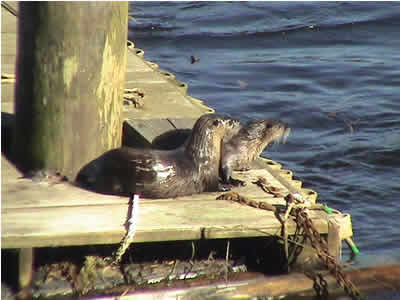
OTTER
The Rest and Cleansing Moon (January 20 to February 18) is the second moon of Waboose position on the Native American Medicine Wheel. The stone for this moon is placed midway between the northern and eastern stones. Silver is the mineral totem for the Rest and Cleansing Moon, the quaking aspen is the plant totem, the otter is the animal totem, and silver is the color. The Butterfly Clan influences this position.
People experiencing this moon are considered as valuable as silver, as lighthearted as the music of aspen leaves, and as playful as the otter. The otter position can help you truly to like people, yourself included, and to be more humanitarian in your views. This is a time when you excel in communicating, in developing your intellect, and in romance. The Rest and Cleansing Moon can help you both to develop your psychic abilities and to uncover the clever, bold, humanitarian, and gentle aspects of your own being. Although otter people have the potential to be noble and loving, they need to guard against dreaming so much that none of their noble ideas ever become reality.
ANIMAL:
Otter is the animal totem associated with the Rest and Cleansing Moon. The otter is one of the most playful animals in the wild. Both river and sea otters exist in the United States.
Otters are members of the weasel family who depend on water for their existence. River otters are found in most of the large lakes, marshes, and rivers of the western United States. Sea otters are larger than those of the rivers are. They are now only found off the northern California coast. The sea otters almost became extinct early in this century because hunters massacred most of them for their fur. The sea otter now spends most of its time in the ocean eating, sleeping, sunning, playing, giving birth, and raising its young.
All otters have large appetites. One of the few animals who can utilize tools, they use rocks to open up their shellfish dinners. Otters have a wide vocal range consisting of chips, squeals, screeches, hiccups, chuckles, and hisses when they are angry. Some of their calls carry for as far as a mile. When otters are not eating, hunting, or sunning they are most often playing.
Otters have warm and active home lives. both parents assist in raising the young who stay with them longer than the young of most wild animals. Otters are ardent companions to each other. A mate will mourn the death of his or her companion.
Because of the otters' exemplary home life, nobility, curiosity, inventiveness, and playfulness, Native people recognized the power of the otter. Some of the most powerful medicine bags in certain tribes were made from the fur of otters. Otter medicine is so strong to some tribes that it is secret until you reach a certain degree of initiation.
Working with otter can teach you about playfulness, nurturing, originality, inventiveness, nobility, curiosity, humanitarianism, companionship, and child rearing.
Article from: http://www.wolfcreekarts.com/otter.html
The Irish Otter
�by Davey Herbert
The Otter lives along riverbanks and beside lakes all around Ireland. It is very good at swimming and diving. The otter has a small-flattened head, a long thick neck and a thick tail that narrows to a point. It can be 3 feet in length, which is about a metre and when they are fully grown up they can weigh about 20 lbs. It has a long body covered with fur. It belongs to the same family as the stoat, pine marten and badger. The otter looks like a seal. The otter is a carnivore, which means that he usually eats meat and often eats shellfish. To get at the shellfish, the otter bangs it against a stone. This way he can get at the food inside. The otter is found in many parts of Ireland. Otters are very playful animals. It has a grey to brown thick coat of fur, which helps it swim well in water. They are often seen jumping in and out of water just for fun, like some of us here in Tramore in the summer.
They are nocturnal animals, which means that they hunt at night. They move around a lot at night and tend to rest by day in their well-hidden homes. Their homes are called a holt. The entrance to the holt is often underwater. A young otter is called a cub or a pup. It takes a cub a few months to learn how to swim. Cubs are blind when they are born. Cubs spend most the time playing in the water. Cubs stay in their home for about eight weeks after they are born. Then its parents bring them outside and teach them how to look after themselves and how to hunt for food. There are usually about two or three cubs in a litter and both parents hunt to feed them.
Some times it looks like otters are fighting but they are just playing, like some fellows in our yard at lunch time. The otter is a member of the weasel family. They also eat frogs and insects. Each otter has five toes. It has webbed feet that stick to the ground. These webbed feet help it to be a good swimmer. There are all kinds of otter all over the world. They don't only play with each other they also play with stones and fish. The otter is scarce throughout Europe and its numbers have grown slightly in Ireland over the years. It is protected under the Wildlife Act of 1976.